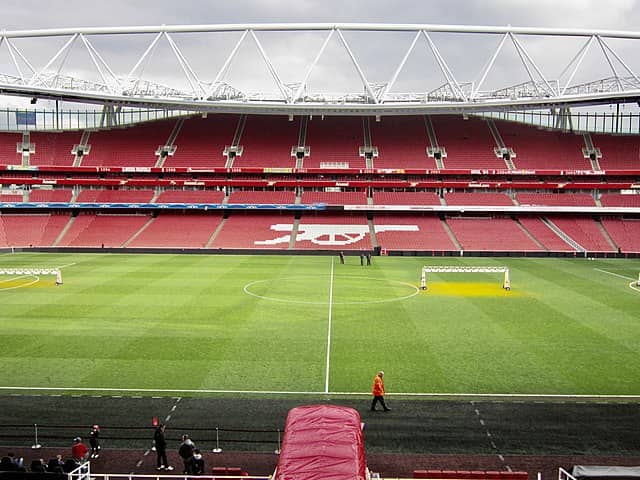Having a good stadium in modern football is important for a club’s image and status. Most clubs in the United Kingdom know this which is why they invest heavily in providing their players and fans with an unforgettable experience. A good stadium will enable fans to create a good atmosphere and keep them wanting to return. We’ve ranked the biggest stadiums in the UK according to size.
Wembley Stadium – 90,000
Wembley is one of the biggest stadiums in the UK with a capacity to accommodate 90,000 fans. The facility opened its doors in 2007 and has hosted some of the biggest events in the sporting world including the 1966 World Cup final, the 1996 European Championship, the 2015 Rugby World Cup, the FA Cup finals, the 2013 UEFA Champions League final and the 1948 Summer Olympics.
Become an insider. Subscribe to our newsletter for more top trending stories like this!
People Also Read: 6 Weird Professional Sports Black People Can Try
Twickenham – 82,000
Twickenham Stadium hosts rugby matches in the Rugby Union and Rugby Football Union. Apart from being one of the biggest stadiums in the UK, it’s also the biggest rugby stadium in the world. Some of the events the venue has hosted include the Rugby World Cup, which Wales has been part of
Old Trafford – 76,000
Also referred to as the Theatre of Dreams, this 76,000-seater is the second-biggest stadium in the UK. Manchester United play their home games here. Some of its legendary employees like Matt Busby and former manager Alex Ferguson have stands named after them.
Old Trafford has been host to major events including the 2003 Champions League final and the UEFA Women’s Champions League.
People Also Read: Cam Newton Worth 2023: Salary, Endorsements, House & Cars
You can find quality footballs on Amazon.
Tottenham Hotspur – 62,850
The newly built Tottenham Hotspur stadium is not only one of the biggest stadiums in the UK but also one of the most beautiful. It’s located in North London and is home to the premier league team Tottenham Hotspur. The club owns the stadium. Apart from football, this stadium can also host American football as it has a retractable pitch.
Join our Spotcovery Global Black Community Facebook Group for early access to exclusive content and to share in a lively discussion.
London Stadium – 62, 500
With a capacity of 62,500, the London Stadium, also called the Olympic Stadium, is one of the biggest stadiums in the UK. It’s located in the Stratford district of London. The facility was built for the 2012 Olympic Games and is currently occupied by the Premier League side West Ham United. It was constructed between 2008 and 2011 for £486 million. E20 Stadium LLP owns the property.
Get a protective football helmet on Amazon.
Celtic Park – 60,411
It’s the home of the Scottish football team Celtic FC. Celtic Park is the largest stadium in Scotland but only ranks fifth in the UK. The ground opened in 1982 and in 1987, Celtic took ownership of it. Also known as Paradise or Parkhead, the stadium has hosted international events like the Commonwealth Games.
People Also Read: 7 Best Nigerian Players Abroad Changing the Football Narrative
Buy football equipment on Amazon.
Become an insider. Subscribe to our newsletter for more top trending stories like this!
The Emirates – 60,260
The Emirates is one of the best stadiums in England. With a capacity of 60,260. It’s the sixth-largest football stadium. It’s home to Premier League side Arsenal FC who moved from the famous Highbury stadium. It was constructed between 2004 and 2006. The ground has 152 executive suites and is owned and operated by Kroenke Sports & Entertainment.
People Also Read: Super Bowl Winners: 10 Amazing Teams That Have Won the Most
The Etihad – 55,907
This is one of the biggest stadiums in the UK and the home of reigning premier league champions Manchester City. It was built between 1999 and 2002 and later renovated between 2002 and 2003. In 2004, the Etihad was expanded from 47,400 seats to 55,907 seats making it the seventh-largest football stadium in the UK.
Manchester City has occupied the venue since 2003. The venue has hosted multiple key sporting events like the 2002 Commonwealth Games, 2005 UEFA Women’s Championships, the 2008 UEFA Cup final and the 2015 Rugby Union World Cup.
People Also Read: How NFL Positions Affect the Game
Anfield – 54,000
Anfield is the home of Premier League side Liverpool football club. With fans singing ‘You Will Never Walk Alone’ at the top of their voices, it provides for one of the best atmospheres in football. Anfield is located in Merseyside, England.
The facility has four stands, Sir Kenny Dalglish stand, the main stand, Spion Kop and the Anfield Rod End. It was built in 1884 and opened the same year. The stadium is owned by Fenway Sports Group.
St James’ Park – 52,405
St James’ Park is the home of Premier League club Newcastle FC. It’s located in Newcastle upon Tyne. It was opened in 1892 and underwent expansion between 1998 and 2000. It’s also one of the oldest grounds in the game. The Newcastle City Council owns St James’ Park.
Hampden Park – 51, 866
Hampden Park, located in Scotland is the tenth biggest football stadium in the UK. The facility was opened in 1903 and is owned by the Scottish Football Association. Scottish clubs Queens Park Rangers, Glasgow Tigers, Celtic FC and Scottish Claymores were the previous occupants of the facility.
These are the biggest and best football stadiums in the UK. They create a good atmosphere and produce a great ambience. Have you been to any of these stadiums?
Nearly 80% of consumers visit directories with reviews to find a local business. List your business for free in our exclusive Spotcovery Black-Owned Business Directory.
Spotcovery offers unique and fresh daily content on Black culture, lifestyle, and experiences. We talk about everything black, black people, black-owned and black-owned businesses. We also deliver authentic and relevant content that will inform, inspire, and empower you! The future of black media is critical to today’s black experience! Our primary audience includes African Americans, Africans, Afro-Caribbean, and people of African heritage. Black culture is for the culture!
Become an insider. Subscribe to our newsletter for more top trending stories like this!





